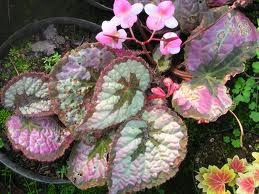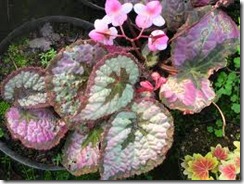Unlike most begonias, rex begonia is grown for its attractive, variegated foliage rather than its colorful flowers. Rex begonias are large houseplants that have highly variable leaves. Foliage can be rough or smooth and streaked with a wide range of colors including pink, yellow, purple and white; leaves grow up to 8 inches long and 6 inches wide, depending on the cultivar. According to the University of Illinois, rex begonias can be fussy plants to grow indoors, but with proper preparation and care they will thrive in your home.
Location
-
Rex begonias need a stable environment to be healthy indoors. Since rex begonia leaves are not completely green, they require a large volume of light for the plant to photosynthesize and acquire enough nutrients to survive. Place the plant in a bright location in your home. Avoid locations near doors, ventilation systems and other areas that may cause draughty conditions that are difficult to control. Rex begonias need stable temperatures between 65 and 80 degrees Fahrenheit and require at least 50 percent humidity to thrive indoors, according to the University of Illinois.
Planting
-
Plant rex begonias in a well-drained potting medium. Lightweight potting mixes that contain perlite or peat-lite formulations are ideal for growing rex begonias, according to the University of Florida. Placing the potting container on a dish that contains stones and water is an effective way to maintain humidity around the plant.
Culture
-
Water rex begonias sparingly; soak the soil only when it is completely dry and the plant appears to need water. Rex begonias are sensitive to over-watering and can develop bacterial problems when soil moisture is too high, according to the University of Florida. Rex begonias benefit from a slow release fertilizer and periodic macronutrient supplements such as fish emulsion.
Propagation
-
Rex begonias are easily propagated by leaf cuttings, according to Iowa State University. Simply remove a leaf with at least 1 inch of the petiole remaining and apply a root hormone to the base of the cutting. Plant the cutting so the leaf barely touches the soil surface and cover the potting container with a clear plastic bag to maintain humidity. Locate the cutting in a bright area in your home, but avoid direct sunlight. Water the cutting occasionally to maintain soil moisture and humidity. Once the cutting has established healthy growth you can re-pot the cutting to a larger container.


Deprecated: strpos(): Passing null to parameter #1 ($haystack) of type string is deprecated in /home/agriviek8Qv/agriviet.net/public_html/wp-includes/comment-template.php on line 2522